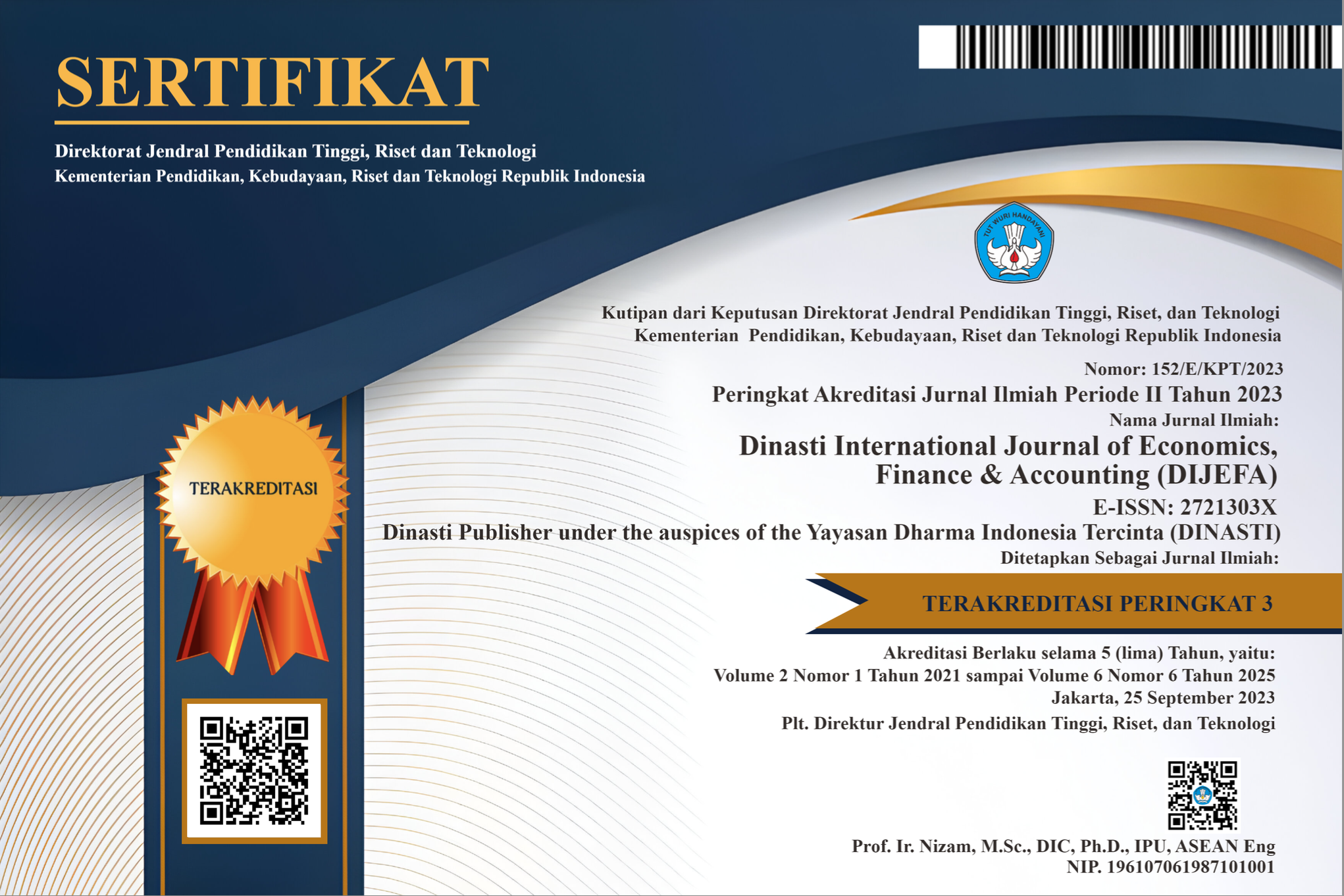Model Relationship Between Performance Criteria And The Most Significant Accounting Of Value-Based Criteria : Economic Added Value (EVA)
DOI:
https://doi.org/10.38035/dijefa.v5i3.3044Keywords:
EVA, Performance Criteria, Bank Value, Panel DataAbstract
Monetary patrons make informed decisions by assessing positive pointers that an association could show from this point forward, rather than relying altogether upon its evident execution. Consequently, this assessment plans to explore the relationship between execution norms and the main worth based estimation: Monetary Added Worth (EVA). Besides, it investigates what future EVA values mean for a bank's overall worth. The audit uses Board Data Examination and OLS Backslide models to assess the backslide condition. The audit separated data from ten banks in the BIST Banks Rundown spreading over the period from 2011 to 2020. In this manner, the Monetary Added Worth (EVA) measures were changed into standardized EVA (SEVA) by parceling EVA by full scale assets. The eventual outcomes of the Standard Least Squares (OLS) backslide assessment showed that the model's illustrative power for the SEVA variable was 71.92%. Extraordinarily, three variables showed positive associations with SEVA: benefit per share (EPS) and TOBINQ at a significance level of 1%, as well as the improvement speed of cost to-bargains at a significance level of 10%. Concerning Board Data Assessment, the SEVA variable showed an illustrative power of 72.14%, with a basic relationship saw among SEVA and the EPS and TOBINQ measures at the 1% significance level. Observational revelations recommend that including future SEVA as a mediator for bank regard holds responsibility, and it is recognized that the SEVA variable can go about as an intermediary measure for bank regard. Concerning Board Data Examination, the SEVA variable displayed a sensible power of 72.14%. Very, its relationship with the pay per share (EPS) and TOBINQ models was seen as immense at the 1% significance level. Careful assessments suggest that the model, which involves future SEVA as a middle person for bank regard, holds ensure. It is recognized that the SEVA variable can go about as a substitute measure for bank regard.
References
Alamsyah, A. A., & Askandar, N. S. (2019). Pengaruh Laba Kotor, Laba Operasi, dan Laba Bersih dalam Memprediksi Arus Kas di Masa Mendatang (Studi Empiris Perusahaan Manufaktur di Bursa Efek Indonesia). E-Jra, 08(01), 53–64.
Armendáriz Lasso, E. (2015). EVA: Economic Value Added. CIENCIA UNEMI, 4(5). https://doi.org/10.29076/issn.2528-7737vol4iss5.2011pp80-86p
Azeem, A., Fayyaz, A., & Jadoon, A. K. (2018). Economic Value Addition Implication?: A Study of the Pakistani Baning Industry. Pakistan Business Review, 19(4), 892–907.
Bayrakdaro?lu, A., & ?am?lo?lu, F. (2011). Performans Ölçümünde Özsermayenin Ekonomik Katma De?eri (Ö-Ekd): ?mkb’de ??lem Gören Bankalar Üzerine Ampirik Bir Uygulama. Kocaeli Üniversitesi Sosyal Bilimler Enstitüsü Dergisi, 21(1), 19–38.
Birkan, R. (2015). Financial Performance of Ölçülmachinede Economics Katma De?er ve Bankac?l?k Sektöründe Piyasa De?eri ile ?li?kisinin Analizi (2004-2013 Borsa ?stanbul Uygulamas?). Gazi University.
Birsen Akta?. (2012). Ekonomik katma de?er ve piyasa katma de?er yöntemlerinin ?MKB-30 endeksine uygulanmas? / Economic value and market value added ISE-30 index implementation methods. Kadir Has Üniversitesi / Sosyal Bilimler Enstitüsü.
Calayo?lu, ?. (2021). Geleneksel Performans De?erlendirme Ölçütlerinin Ekonomik Katma De?ere Etkisi: Bili?im Endeksi Uygulamas? (XBLSM) (The Effect of Traditional Performance Evaluation Criteria on the Market Value Added: Application on Informatics Index (XBLSM)). Journal of Business Research - Turk, 12(3), 2543–2555. https://doi.org/10.20491/isarder.2020.992
Demirgüne?, K. (2009). Kurumsal yönet i? m uygulamalarinin f i? rma de ? er i? üzer i? ne etk i? ler i?. N??DE ÜN?VERS?TES?.
Dervi? Boztosun. (2017). Comparison of EVA (Economic Value-Added) and Accounting Profit in Explaining Share Returns of Deposit Banks. China-USA Business Review, 16(12), 565–575. https://doi.org/10.17265/1537-1514/2017.12.001
F?GANKAPLAN, T. (2020). Bankalar?n Piyasa De?eri ile Ekonomik Katma De?eri Aras?ndaki Nedensellik ?li?kisi: Panel Nedensellik Analizi. BDDK Bankac?l?k ve Finansal Piyasalar Dergisi, 14(1), 39–64. https://doi.org/10.46520/bddkdergisi.789946
Gounder, C. G., & Venkateshwarlu, M. (2017). Shareholder Value Creation: An Empirical Analysis of Indian Banking Sector. Accounting and Finance Research, 6(1), 148. https://doi.org/10.5430/afr.v6n1p148
Günay, B., Kurtaran, A. T., & Faedfar, S. (2021). A model proposal for estimating banks’ future value: Evidence from Turkey. Banks and Bank Systems, 16(4), 169–178. https://doi.org/10.21511/bbs.16(4).2021.14
Ongeri, B. O. (2014). Economic Value - Accounting Value Nexus: –The Effect of Accounting Measures on Economic Value Added Amongst the Kenyan Commercial Banks. Journal of Contemporary Research in Accounting, Auditing and Business Ethics (GJCRA), Vol: 1 Iss(3), 182–200. Retrieved from http://erepository.uonbi.ac.ke/bitstream/handle/11295/80108/Ongeri_Economic value - accounting value nexus.pdf?sequence=1
P.Muraleetharan, Kosalathevi, T. (2014). “ Impact of Economic Value Added on Financial Performance ”: Special Reference to Selected Private Banks in Sri Lanka . European Journal of Business and Management, Vol.6, No.(13), 102–108.
Puspitasari, N., Sa’diah, H., Prasetiyaningtiyas, S., & Sukarno, H. (2022). ANALISIS PENGARUH EVA (ECONOMIC VALUE ADDED) DAN MVA (MARKET VALUE ADDED) TERHADAP RETURN SAHAM PERUSAHAAN MANUFAKTUR SUBSEKTOR FARMASI DI BURSA EFEK INDONESIA. VALUE: Journal of Business Studies, 1(1). https://doi.org/10.19184/value.v1i1.31658
Simbolon, F, Dzulkirom, Saifi, M. (2014). Analisis EVA (Economic Value Added) untuk Menilai Kinerja Keuangan Perusahaan (Studi Pada Perusahaan Farmasi Pada Bursa Efek Indonesia Periode 2010-2012). Jurnal Administrasi Bisnis S1 Universitas Brawijaya, 8(1).
Udiyana, I. B. G., Astini, N. N. S., Parta, I. N., Laswitarni, N. K., & Wahyuni, L. A. (2022). Economic Value Added (EVA) and Market Value Added (MVA) Implications on Stock Returns. Jurnal Ekonomi & Bisnis JAGADITHA, 9(1). https://doi.org/10.22225/jj.9.1.2022.15-22
Yulianti, Y., Wahdi, N., & Saifudin, S. (2017). Model Prediksi Arus Kas Masa Depan Pada Emiten Lq45 Yang Terdaftar Di Bursa Efek Indonesia. Jurnal Dinamika Sosial Budaya, 17(2), 323. https://doi.org/10.26623/jdsb.v17i2.496
Downloads
Published
How to Cite
Issue
Section
License
Copyright (c) 2024 Rafika Sari Vhika Meiriasari, Veika Meiriasari

This work is licensed under a Creative Commons Attribution 4.0 International License.
Authors who publish their manuscripts in this journal agree to the following conditions:
- The copyright on each article belongs to the author(s).
- The author acknowledges that the Dinasti International Journal of Economics, Finance & Accounting (DIJEFA) has the right to be the first to publish with a Creative Commons Attribution 4.0 International license (Attribution 4.0 International (CC BY 4.0).
- Authors can submit articles separately, arrange for the non-exclusive distribution of manuscripts that have been published in this journal into other versions (e.g., sent to the author's institutional repository, publication into books, etc.), by acknowledging that the manuscript has been published for the first time in the Dinasti International Journal of Economics, Finance & Accounting (DIJEFA).


























































